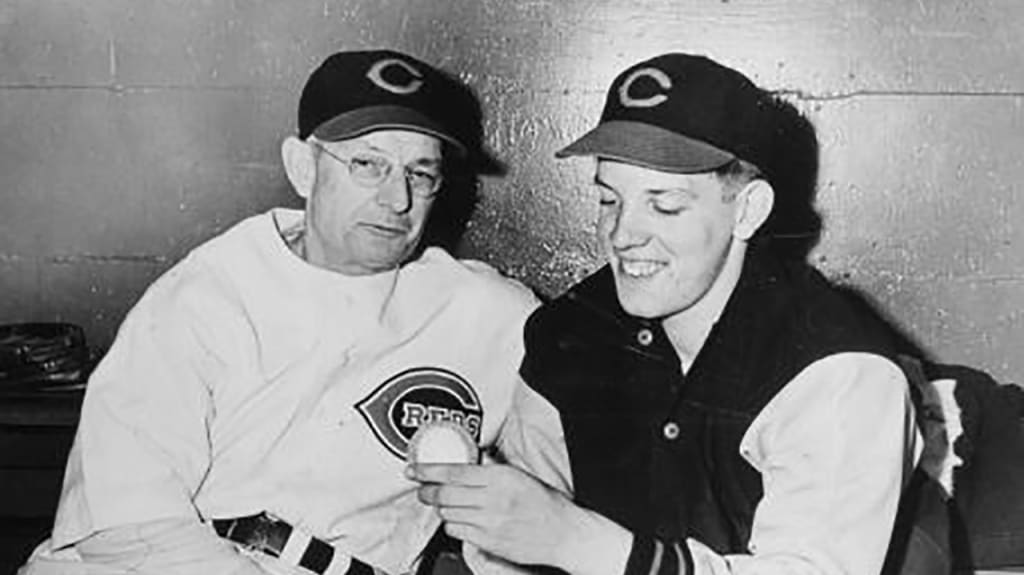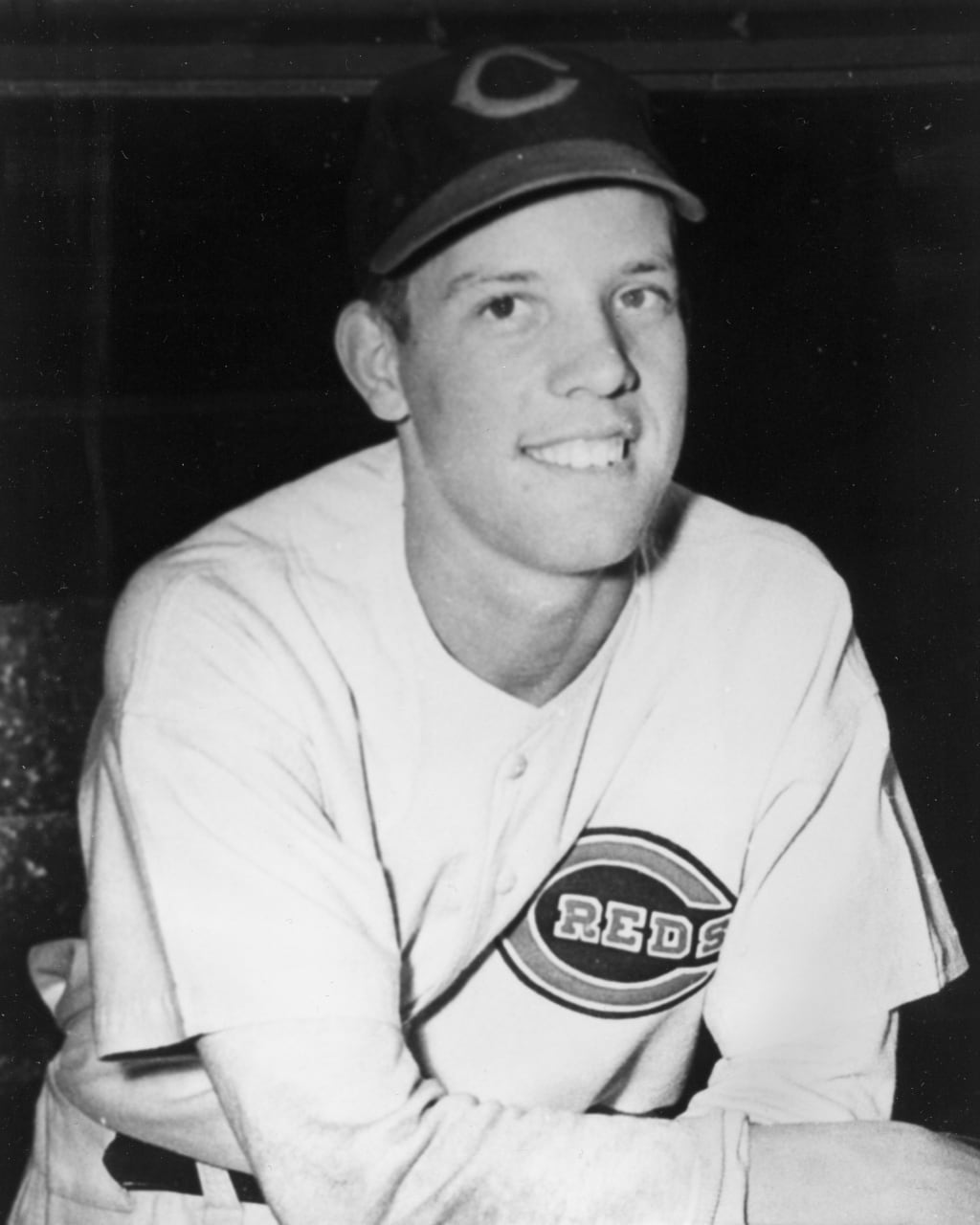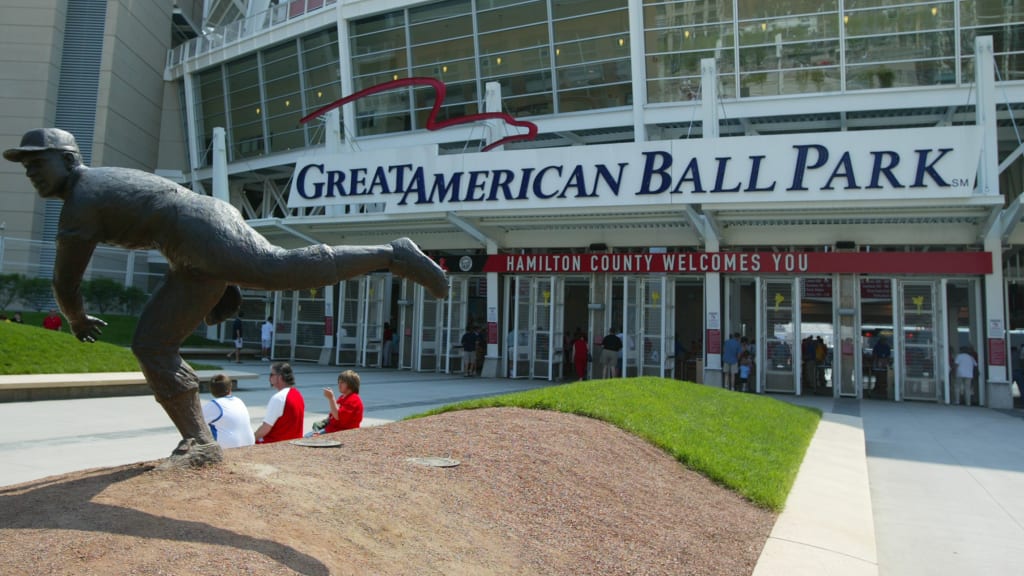
A version of this story original ran in February 2022.
With an increasing number of players being called to serve in World War II and baseball¡¯s color barrier still several years away from being broken, the AL/NL talent pool was seriously depleted by 1944.
That's how a 15-year-old found himself on the Reds.
Today marks the anniversary of the day in 1944 when teenager Joe Nuxhall signed a contract with Cincinnati for a reported $175 a month plus a $500 signing bonus, beginning a remarkable baseball odyssey.
Nuxhall, who passed away in 2007 after battling cancer, remains the youngest player to appear in an AL/NL game. But after making his big league debut in 1944, the left-hander wouldn't log another MLB appearance for eight years.
This is the story of a baseball prodigy who quickly flamed out, briefly stepped away from the game, toiled away in the Minors for years, eventually made it back to The Show and went on to become an icon in Cincinnati.
Joining the Reds
Initially, the Reds were interested in Nuxhall's father, Orville, a semi-pro pitcher.
¡°I've told the story often,¡± Nuxhall said in an interview with the New York Times in 1976. ¡°They were scouting my father. It was just playground ball in Hamilton [Ohio]. My father, who was about 36, was pitching for one team and I was on another. These two scouts came to Diamond No. 1 on this playground complex where we had a game already started.
¡°¡®Where's Ox?¡¯ they said. Everybody called my father Ox. ¡®He's over on Diamond No. 3,¡¯ somebody told them. ¡®Who's that kid pitching?¡¯ one of the scouts asked. 'That's Ox's son,' they told 'em.
¡°So they stayed and watched me and then they invited me to Cincinnati for a look. They offered my father a tryout, too, but he had five kids to feed and couldn't take the gamble. He was working in a plant that made locomotives and diesel engines.
¡°But the way I always tell it is I beat my father out of a job,¡± he joked.
Nuxhall, who was 14 at the time, attended a tryout at Crosley Field in the summer of 1943. Standing well over six feet tall and possessing a live left arm, he impressed Reds manager Bill McKechnie and was given an opportunity to travel with the team on a road trip to St. Louis.
¡°I pitched batting practice for three days in the Cardinal park at St. Louis,¡± Nuxhall later recalled to The Journal Herald. ¡°I also would have gone to Chicago with the Reds, but had to return home for the opening of the school term.¡±
Nuxhall had been bred to love the game of baseball from a young age. But before the chance to play for the Reds emerged, he was forging a promising path in another sport, excelling at center for the Wilson Junior High School basketball team, with plans to play hoops once he arrived at Hamilton High School in 1944.
According to sportswriter and baseball historian Lee Allen, then the Reds¡¯ publicity director, Nuxhall didn¡¯t sign with the club until February because he wanted to preserve his amateur standing for the basketball season.
The Reds finally got him under contract on Feb. 18, 1944, with his father signing the deal on his son¡¯s behalf. Reds officials were adamant that the team hadn't signed the youngster solely because of the talent drain from the war.
¡°Nuxhall is a great prospect,¡± Cincinnati general manager Warren Giles told The Associated Press. ¡°We are not signing him because of the war situation. Two other clubs wanted him, and he would have been signed, war or no war.¡±
¡°This boy is not just a wartime blossom who will fade in big-time baseball,¡± McKechnie said. ¡°He has more poise than most youngsters and knows all the tricks by instinct.¡±
Although he ¡°played hooky,¡± as the Dayton Daily News put it in a story published on April 19, 1944, to suit up for the Reds on Opening Day (in reality, he had permission from his principal), Nuxhall didn¡¯t make his MLB debut until after the school term ended in June. By then, he was raring to go.
¡°I¡¯m all set,¡± he told the Dayton Herald. ¡°I¡¯m convinced I¡¯m making the right move in going right into the Reds¡¯ camp instead of agreeing to let them farm me to the Minor Leagues. I know I can learn a lot from Mr. McKechnie, Bucky Walters and the other players. Mr. McKechnie hasn¡¯t told me what he has planned from my program. Would I like to get in a big league game? What do you think I¡¯ve been waiting for all these months?¡±
He got his chance on June 10, 1944, against the Cardinals. With the Reds trailing 13-0, McKechnie called on the youngster to pitch the ninth inning.
"He must have called to me three times," Nuxhall said in his biography, "Joe: Rounding Third and Headed for Home." "I wasn't paying attention. I never thought they would put me in the game. I figured I would just sit there until they decided where they were going to send me. Tell ya the truth, I was shocked."

Nuxhall retired two of the first three batters he faced, with a walk in between, but after a wild pitch and another walk, he found himself face to face with 1943 NL MVP Stan Musial.
Musial laced a single to right field to load the bases, and Nuxhall walked in three runs before giving up a two-run single to Emil Verban, prompting McKechnie to pull him from the game.
"All of a sudden, I couldn't throw a strike," Nuxhall said in the book. "Couldn't come close. Damndest thing. I guess I finally realized where I was, what I was doing. But, you know, three weeks before that, I was pitching to junior high school guys in Hamilton. My nerves just started getting to me."
Nuxhall¡¯s debut line read as follows: five runs allowed on two hits and five walks in 2/3 of an inning.
It would be 2,902 days before he was able to get that third out.
Back to school
Following his rocky debut, the Reds optioned Nuxhall to Birmingham. He remained in the Minors through 1945, then decided to put his professional baseball career on hold until he finished high school.
In 1946, the Ohio High School Athletic Association reinstated Nuxhall for amateur competition, and he went on to earn all-state honors in football and basketball.
He returned to the pro baseball ranks in the summer of 1947, and for the next five years he pitched for various Reds-affiliated Minor League teams, honing his craft in hopes of earning another big league opportunity.
Nuxhall pitched for Double-A Tulsa in 1951 and later credited Tulsa manager Al Vincent with helping him learn to cope with his longstanding control problems.
¡°I had the habit of becoming so mad at myself for giving base on balls that I would lose all control over my pitches and walk other batters to bring my trouble piling down on top of me,¡± he told the Cincinnati Post while attending Reds Spring Training in February 1952. ¡°After I had done this a few times for the Tulsa team last year Vincent laid down the law to me.¡±
According to Nuxhall, Vincent told him he would pull him from the game if he displayed his temper on the mound, regardless of the score or the inning.
¡°I saw that he meant it, and for a while every time I happened to walk a batter, I took a grip on myself and paid attention to fighting the other team instead of myself,¡± Nuxhall said. ¡°In time the habit of losing my temper over walking a batter disappeared and I became more capable in every respect. Curbing my temper was the greatest advance I have made so far in pitching. From now on I¡¯m going to concentrate on improving my control and deception.¡±
Nuxhall made the Reds out of Spring Training, but he¡¯d have to wait just a bit longer to complete his comeback: He registered nary an appearance in the team¡¯s first 28 games of the 1952 campaign.
A lengthy career
At long last, Nuxhall was called upon to pitch for the Reds against the Dodgers in Brooklyn on May 21, 1952.
He came into a strikingly similar situation to the one he faced against the Cardinals in 1944, with the Reds trailing the Dodgers 19-1. But unlike his first appearance, the lefty held his opponent in check, firing three scoreless innings with three strikeouts and no walks.
Nuxhall finished his rookie season with a 3.22 ERA over 92 1/3 innings, proving that he belonged in the Majors. He earned back-to-back All-Star selections in 1955-56, a stretch in which he recorded a 3.58 ERA across 457 2/3 innings.
The Reds traded him to the A's in 1961, but after brief stints with Kansas City, the Orioles and the Angels, he returned to Cincinnati in 1962 and remained with the club until his final season in 1966, his age-37 campaign.
All told, Nuxhall went 135-117 with a 3.90 ERA and 1,372 strikeouts in 2,302 2/3 innings spanning 16 seasons.
Along the way, he picked up the nickname ¡°The Ol¡¯ Left-hander,¡± ironic considering his status as the youngest player in AL/NL history.
After the end of his playing career, Nuxhall immediately moved into the Reds¡¯ broadcast booth, eventually forming a partnership with Ford C. Frick Award winner Marty Brennaman until retiring from full-time duty in 2004.

Following his death on Nov. 15, 2007, Great American Ball Park's address was changed to 100 Joe Nuxhall Way. A statue of the pitcher stands outside the stadium alongside other Reds greats, and a sign bearing part of his famous radio signoff -- "This is the Ol' Left-hander, rounding third and heading for home" -- hangs on the park's exterior facade.
An estimated crowd of at least 6,000 people attended a public visitation at the high school in Fairfield, a suburb of Cincinnati, to pay their respects to Nuxhall. Former Reds Ken Griffey and Ken Griffey Jr., Barry Larkin, Sean Casey and Pete Rose were among those in attendance.
On Opening Day in 2008, the Reds honored Nuxhall by wearing his name and No. 41 on their jerseys during pregame ceremonies. Cincinnati starting pitcher Aaron Harang received permission from Major League Baseball to wear the jersey during the game instead of his usual No. 39. The team also wore a "NUXY" sleeve patch for the entire season.
Brennaman in 2003 summed up what his longtime broadcast partner meant to the Reds:
"I have no reluctance in saying this: There¡¯s been more popular players. But there is not a more popular figure in the history of this great franchise."


